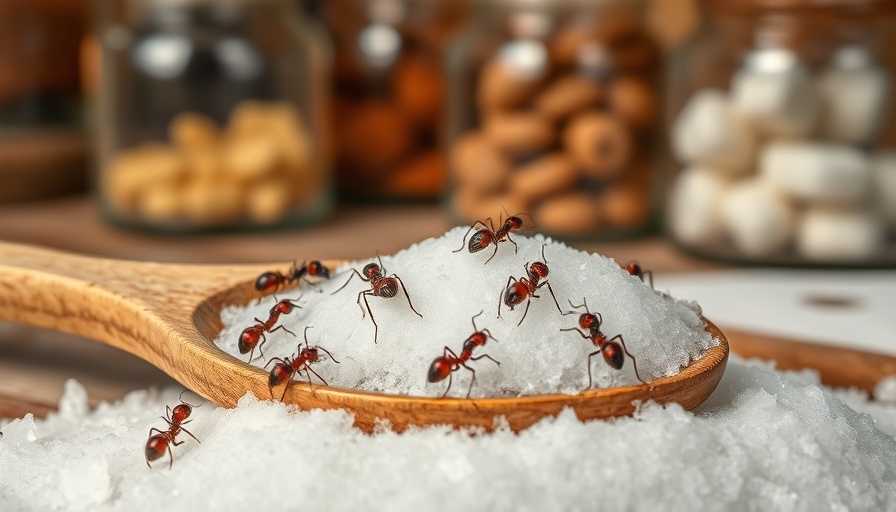
Conquering Sugar Ants: Understanding Your Tiny Foes
Sugar ants, which include species such as odorous house ants, pharaoh ants, and carpenter ants, thrive on sweet substances and can quickly turn your kitchen into their home base once they find a food source. As they forage for food, they leave behind pheromone trails, which draw more ants to the area. Understanding their behavior and preferences is crucial in battling these persistent pests.
Effective Strategies to Get Rid of Sugar Ants
When you discover sugar ants in your kitchen, acting swiftly is imperative. Here are some effective strategies experts recommend:
1. Seal Access Points to Your Home
Identifying and sealing off entry points is the first step in controlling sugar ant infestations. Check windows, doors, and gaps in your home’s foundation for potential ways these tiny invaders could be getting in. Use caulk to fill gaps and ensure weather stripping is intact to keep them outside.
2. Clean Thoroughly and Consistently
Sugar ants are always on the lookout for crumbs and spills. Regularly clean your kitchen surfaces, wipe down counters, and ensure that food is stored in sealed containers. Cleanliness is critical; even the tiniest residue can attract sugar ants.
3. Natural Repellents: Vinegar and Essential Oils
White vinegar is effective as both a cleaner and an ant repellent. Mix equal parts of vinegar and water in a spray bottle and apply it to areas where ants are spotted. Additionally, essential oils such as peppermint and eucalyptus can deter ants. Create a spray with a few drops of essential oil mixed with water and apply it to surfaces that attract ants.
4. Deploying Bait Traps
Baits containing food and a slow-acting toxin can significantly help eliminate sugar ants. Worker ants bring the poisoned bait back to their nests, gradually affecting the entire colony, including the queen. Popular bait options include Terro and Raid products, which are known for their effectiveness. One homemade bait trap is to mix 1 teaspoon of Borax, 5 tablespoons of sugar and dissolve in 1 cup of warm water. Stir until the Borax and sugar are completely dissolved. Using a small, shallow cap (beer caps work well ;-) fill the cap with the Borax/sugar water solution - place on the ant's pathway away from pets. After several hours the ants will look like horses around watering trough. The borax is converted to boric acid in the ants digestive system poisoning the ant preventing food assimilation essentially starving the ant. Boric acid also attacks the ant's exoskeleton resulting in dehydration. The bait is also taken back to the colony eventually causing the entire colony to perish.
5. Professional Pest Control Solutions
In cases where DIY methods fail, it may be time to enlist the help of professionals. Pest control experts can assess the extent of the infestation and employ more effective strategies to ensure long-term prevention. Their experience and expert tools mean they can often eliminate sugar ants more quickly and completely than typical household methods.
Preventing Future Infestations: Safeguard Your Home
Once you’ve dealt with sugar ants, preventing a re-infestation should be your next priority. Here are several measures to consider:
1. Regular Landscaping and Yard Maintenance
Maintain landscaping around your home by using rocks or gravel, which can deter sugar ants from approaching your abode. It's also wise to inspect mulch areas around the home, as these can be nesting sites for ants.
2. Track Moisture and Repair Any Leaks
Sugar ants are also drawn to moisture. Repair leaky faucets and ensure areas of high humidity are properly ventilated or dried out. Regular checks can help maintain a less attractive environment for ants.
3. Keeping Food Sealed and Tidying Up Regularly
Food storage is essential. Store sugar, grains, and snacks in airtight containers and avoid leaving out any food overnight. Nightly kitchen sweeps to ensure cleanliness can make a significant difference.
Final Thoughts on Sugar Ants
Sugar ants may seem small, but they can lead to big problems if left to thrive indoors. A combination of immediate action and long-term prevention techniques can help keep your home ant-free. Consistency and vigilance are key in ensuring your kitchen isn’t a paradise for these sugary little pests.
#SugarAnts, #AntControl, #PestPrevention, #BoraxBait, #NaturalRepellents, #KitchenCleaning, #SealEntryPoints, #ProfessionalPestControl, #AntInfestation, #FoodStorage
 Add Row
Add Row  Add
Add 




Write A Comment